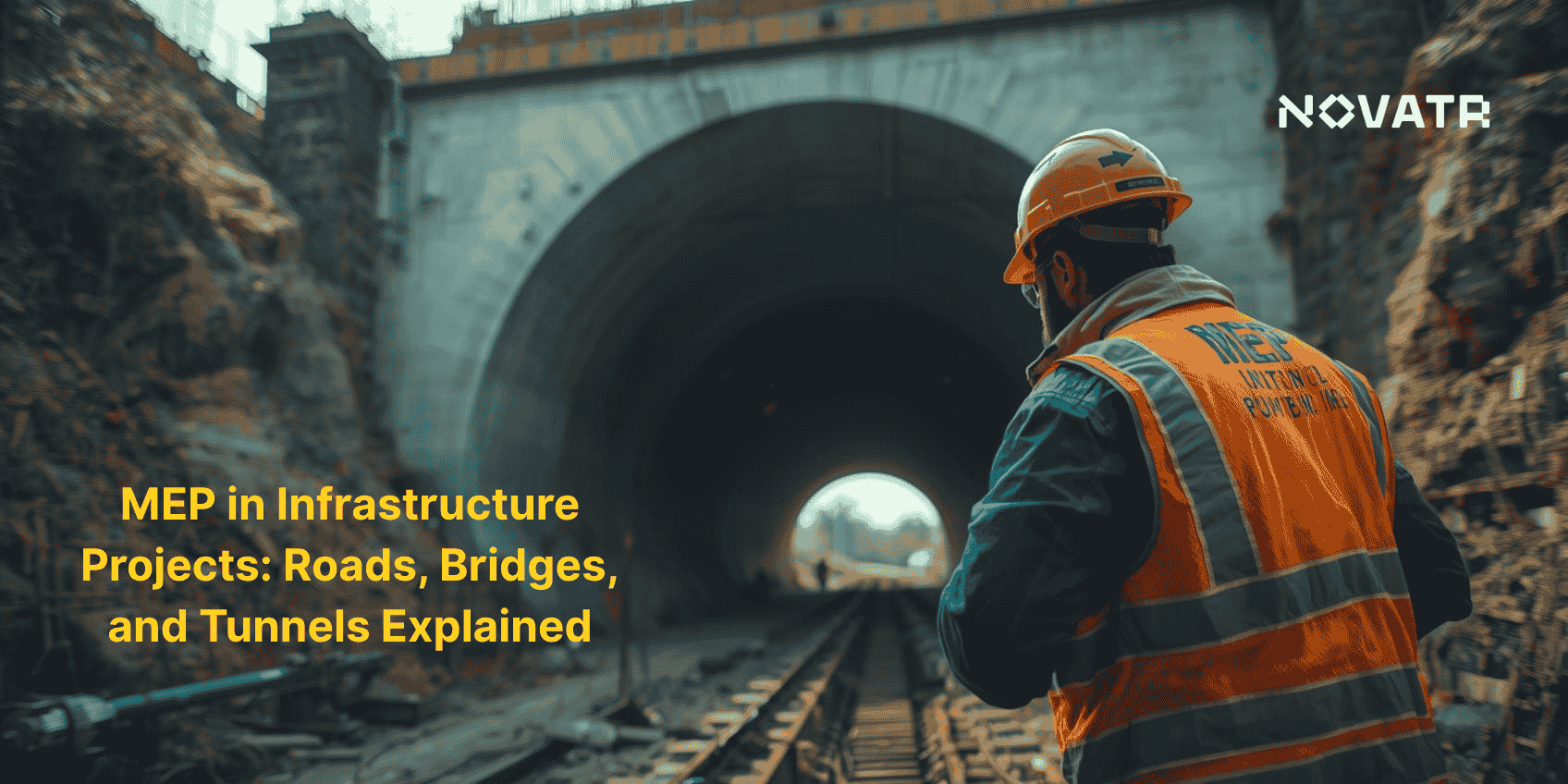
Infrastructure projects such as roads, bridges, and tunnels involve integrating multiple systems to maintain reliability and efficiency over time. Engineers must consider materials, environmental factors, and operational demands to ensure functionality. In the USA, the MEP project engineer salary averages $92,358 per year, reflecting the expertise required to deliver effective road MEP solutions that enhance safety and longevity.
In tunnels and underground structures, mechanical, electrical, and plumbing systems must work seamlessly with structural designs. Challenges such as ventilation, lighting, and water management require careful planning to ensure safety and performance. Thoughtful transportation MEP design promotes energy efficiency, regulatory compliance, and long-term durability, helping infrastructure maintain consistent operation under varying conditions and environmental demands.
What is the Role of MEP Systems in Infrastructure Projects like Roads, Bridges, and Tunnels?
MEP systems are essential for maintaining efficiency, safety, and durability in large-scale infrastructure. They integrate mechanical, electrical, and plumbing elements with structural designs while addressing environmental and operational demands. Using civil infrastructure MEP approaches ensures long-term performance, and MEP in tunnels provides reliable functionality in complex underground environments, supporting overall project effectiveness.
Here is an overview of how MEP systems contribute to infrastructure projects:
-
Facilitates the integration of advanced monitoring and control technologies to enhance operational performance and quickly identify potential issues before they escalate.
-
Supports specialized solutions for drainage, fire safety, and emergency power systems, ensuring reliable functionality in large-scale infrastructure.
-
Enhances the adaptability of the infrastructure to accommodate future upgrades or expansions without major reconstruction.
-
Improves coordination between contractors, engineers, and maintenance teams to reduce delays and operational disruptions.
-
Enables efficient management of materials and resources during construction and ongoing operation, reducing costs and limiting waste.
-
Illustrates how do MEP engineers design systems for road infrastructure to ensure effective planning, reliable operation, and maintainability.
What Are the Key Challenges in Designing MEP for Outdoor and Underground Structures?
Designing MEP systems for outdoor and underground infrastructure involves multiple factors, including environmental conditions, structural constraints, and operational requirements. Engineers must ensure mechanical, electrical, and plumbing systems are integrated effectively to maintain reliability and long-term performance. This planning also considers why ventilation and HVAC are critical in tunnel MEP design, influencing airflow and environmental conditions within underground structures.
Here are the key challenges faced when designing MEP systems for outdoor and underground structures:
-
Managing space limitations and system complexity to fit mechanical, electrical, and plumbing components within constrained structural layouts.
-
Addressing exposure to environmental conditions such as moisture, temperature shifts, and corrosive elements that can degrade system performance.
-
Ensuring structural support for heavy MEP equipment without compromising the integrity of roads, bridges, or tunnels.
-
Maintaining accessibility for inspections, repairs, and upgrades while minimizing operational disruptions in high-traffic or critical areas.
-
Overcoming visibility, control, and operational limitations in underground environments is a critical challenge, which highlights the importance of electrical and lighting design in tunnels for safe and effective operation.
-
Implementing safety protocols and monitoring systems effectively to handle emergencies, highlighting how MEP ensures safety in large infrastructure projects.
Also Read: Top 50 MEP Interview Questions & Answers 2025
How Do MEP Systems Improve Durability, Energy Efficiency, and Compliance in Infrastructure?
MEP systems enhance infrastructure by integrating building services with structural and operational requirements to ensure efficient performance. Effective coordination of MEP with civil teams in infrastructure projects allows accurate installation, smooth maintenance, and compliance with safety and regulatory standards. This collaboration improves long-term durability, optimizes energy use, and maintains reliable operation across roads, bridges, and tunnels. By aligning design and operational processes, MEP systems support sustainable infrastructure that meets functional, environmental, and regulatory demands.
Key ways MEP systems contribute to durability, efficiency, and compliance include:
-
Using high-quality materials and precise installation practices to extend the lifespan of components, minimize wear, and maintain consistent performance in MEP in roads.
-
Optimizing service systems such as lighting, ventilation, and power distribution to lower energy consumption while improving overall operational efficiency.
-
Ensuring alignment with safety regulations, environmental requirements, and building codes to guarantee compliance across all phases of the infrastructure lifecycle.
-
Implementing comprehensive monitoring, diagnostics, and preventive maintenance schedules to identify potential issues early and sustain system performance over time.
-
Enhancing structural integration, load distribution, and coordination with civil elements to ensure long-term durability and resilience in MEP in bridges.
-
Supporting sustainable infrastructure operations through careful resource management, energy-efficient practices, and adherence to environmental standards.
Also Read: Boost Your MEP Engineering Career with BIM Mastery
How Does BIM Support Planning, Design, and Coordination in These Large-Scale Projects?
BIM enhances large-scale infrastructure projects by enabling better visualization, accurate documentation, and streamlined communication between stakeholders. Effective use of BIM for MEP engineers helps integrate multiple disciplines into a single coordinated model, improving planning, reducing errors, and supporting informed decision-making. This approach facilitates smoother project execution across roads, bridges, and tunnels while ensuring operational and regulatory requirements are considered.
BIM supports planning, design, and coordination in the following ways:
-
Providing 3D modeling that allows stakeholders to clearly visualize structural layouts, MEP components, and architectural features, enhancing understanding of complex project elements.
-
Detecting potential clashes and conflicts between different disciplines early in the design process, reducing costly errors, rework, and delays during construction.
-
Streamlining documentation, reporting, and record-keeping to ensure all designs meet regulatory requirements and maintain consistent quality standards.
-
Facilitating real-time communication and updates across multidisciplinary teams, enabling seamless collaboration and ensuring all parties remain aligned throughout project execution.
-
Enhancing overall workflow efficiency by using MEP software to analyze designs, validate system performance, and optimize installation plans for accuracy and reliability.
-
Supporting complete lifecycle management by integrating planning, construction, and ongoing maintenance data, which improves operational efficiency of infrastructure projects.
Conclusion
Effective planning, integration, and maintenance are essential for the long-term success of infrastructure projects. Applying best MEP practices for bridges, tunnels, and roads ensures durability, energy efficiency, and compliance across complex environments. Coordinating design with operational needs and environmental conditions helps maintain safe, reliable performance while supporting adaptability for future upgrades and regulatory standards in large-scale projects.
For professionals seeking structured learning, the BIM Course for MEP Engineers offered by Novatr provides in-depth guidance on planning, coordination, and system optimization. This course complements the practical understanding of infrastructure design and execution. Visit our resource page to explore detailed insights, case studies, and guidance that support informed decision-making in road, bridge, and tunnel projects.
FAQs
1. What is the role of MEP systems in infrastructure projects?
Ans: MEP systems ensure that infrastructure operates efficiently, safely, and reliably over its lifespan. They integrate essential services with structural designs while addressing environmental and operational demands. This coordination supports durability, energy efficiency, and compliance across roads, bridges, and tunnels.
2. How are MEP systems integrated into road construction projects?
Ans: MEP systems are incorporated during the planning and design phases to align with road layouts and structural requirements. This includes lighting, drainage, and power distribution solutions that enhance functionality and safety. Careful coordination minimizes operational disruptions and supports long-term maintenance.
3. What types of MEP systems are used in bridges?
Ans: Bridges typically use electrical, lighting, drainage, fire safety, and mechanical support systems. These components are integrated with the bridge’s structure to ensure resilience and operational reliability. Proper implementation enhances safety, energy efficiency, and durability under variable conditions.
Was this content helpful to you



.jpg)
.png)


.png)